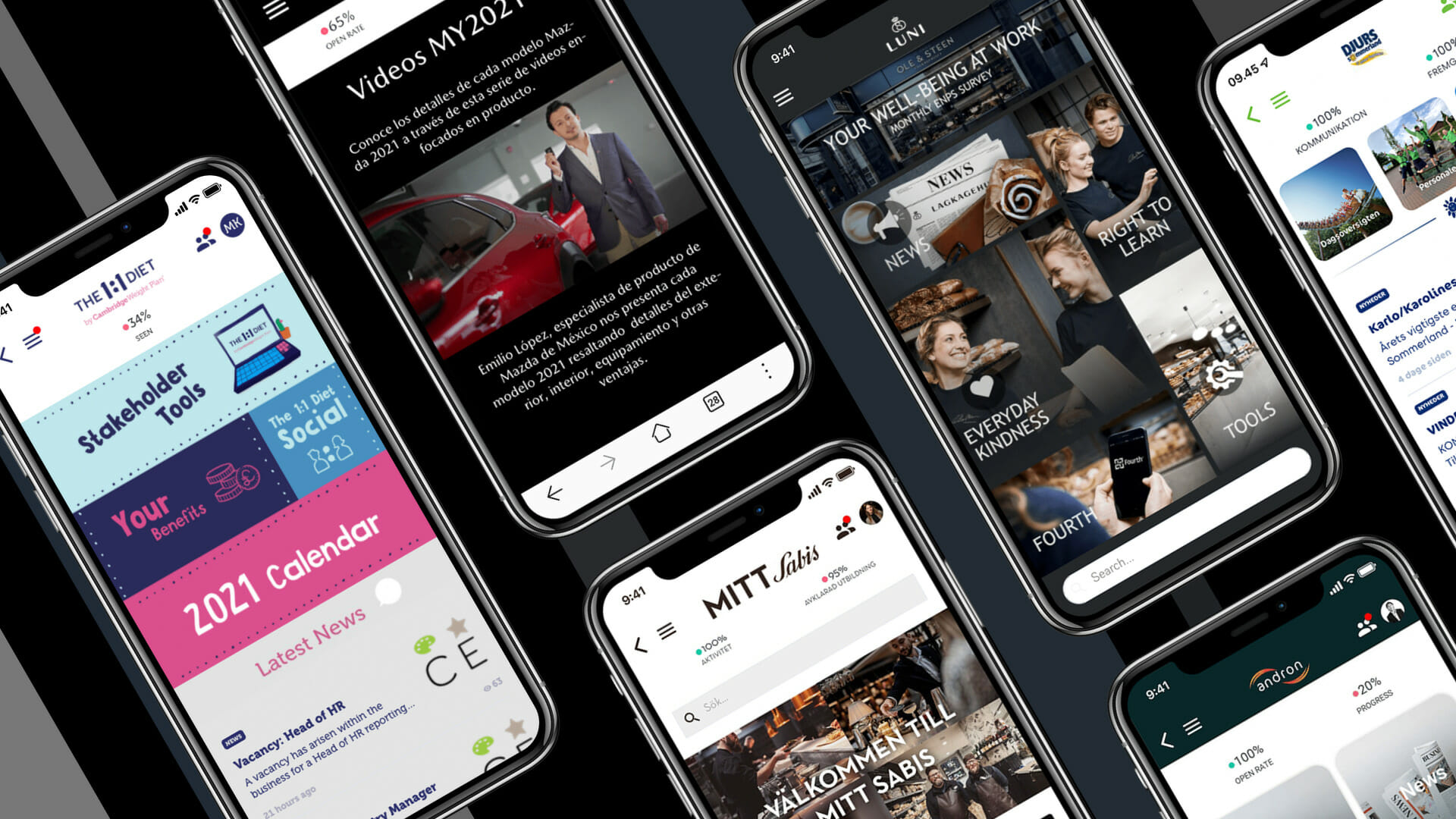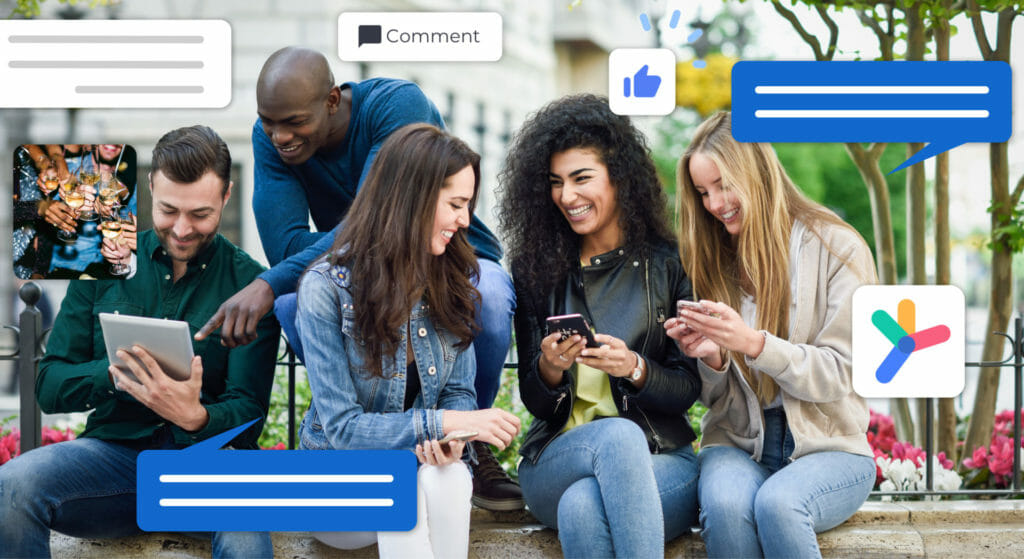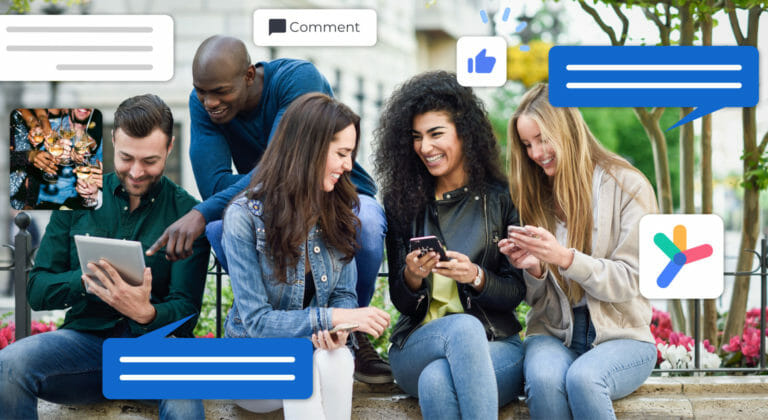Creating engaging content as part of your organizational communications strategy is a sure way to keep employees motivated, particularly remote and non-desk employees. But, what drives an effective communication strategy?
Let’s start with the basics.
What is organizational communication?
Organizational communication is all about the flow of information in the workplace, and investing in it is a pillar of business success.
The most common forms of internal communication are horizontal (communication and collaboration amongst teams), and vertical (between leaders, managers, and employees).
Indeed, The Institute of Internal Communication states: “Successful internal communication creates an environment of mutual understanding. It forges connections between people, allowing them to perform at their best, both individually and collectively.”
It can happen in formal or informal ways! In fact, social communication also plays an important role in building a positive company culture.

Why is effective communication important?
The workplace is evolving quicker than ever, demanding innovative ways to reach and engage employees from any location.
Good internal communication supports your business objectives, goals, and values. And it links directly to your team’s willingness to go the extra mile for the company and its customers. 85% of employees said they’re most motivated when management offers regular updates on company news.
Your internal communication will improve greatly if you’re able to focus on sharing great content. Communication needs to be clear, relevant, and spark inspiration. Look for inspiring stories from across the organization and explore creative ways to bring that information to life. For example, EET Group is sharing best practices in video format across their markets in Europe, using their employee app powered by Actimo.
Communication doesn’t need to be difficult.
In a digital world where we’re overloaded with content every day, it’s so easy to get distracted. Even though employers may be increasingly using mobile devices to connect with their teams, messages can still become fragmented across channels or go unnoticed by employees.
Indeed, with millions of messages and billions of emails sent every minute, we scroll through on average 300 feet of content per day. This means you have just a few seconds to convince your workforce of the value of your content. So, it’s important to keep it simple and engaging. Keep in mind as well, that only a portion of employees has access to email– many non-desk workers do not have a work email address, nor are they in the habit of using an email for example.
The purpose of your internal comms is to connect, align, and engage ALL employees, so think about the following questions:
- Are your organizational communications useful?
- Are they reaching your entire company?
- Are they improving employee engagement?
- Is the messaging communicated clearly?
5 ways to create engaging content for internal comms
It may be time to evaluate your communication strategy and how it aligns with your overall business goals. Incorporating innovative ways to communicate with your workforce can make a difference in enhancing the overall employee experience.

-
Use the right tools.
Firstly, you want to connect your team with a user-friendly employee experience they’ll actually use and enjoy. Actimo makes internal communication simple with an engaging and insightful mobile-first platform for non-desk employees.
Using the right tools empowers your employees to communicate asynchronously, so you can unite everyone from frontline workers right through to the CEO.
Using one platform to connect your entire workforce also means teams can consume and engage with content in their own time, with no distractions.
With Actimo, for example, you choose whether you want to send a push notification, SMS, or email or and then employee groups (however you want to segment them) can access your content. You can even track who has read your content to ensure no one is left out of the loop!
-
Use different methods to package your message.
To engage employees, you want to ensure you drive conversations. The best way to do this is to showcase your content in a variety of ways.
Using authentic visuals helps to tell a story and makes your content personable and memorable. People will resonate more with human-centered storytelling.
Visual formats like images, videos, or infographics will also draw your readers in and makes complex information easier to digest.
Thinking creatively about how to share your content, such as hosting a photo competition, collecting employee insights, and using two-way communication, prevents your content from becoming boring. Finally, it’s communication your people want to read!
-
Ensure everyone can use their voice.
Organizational communication is a process where everyone should feel included. The mindset that communication is only about pushing messages to employees about business issues, policies, and procedures is outdated. Furthermore, one-way communication has several disadvantages to consider!
Make room for different types of communication in the workplace. With Actimo, the Social Wall and groups for teams break down contact barriers and welcome everyone to share their stories and opinions. The more your teams and departments communicate, the better everyone can work towards the same goals.
Streamlining the flow of information is also a great way to decrease the spread of misinformation and build trust in the workplace.
-
Select the most valuable information to share.
Communicators should aim to provide value in the content they share to overcome the sea of content already exposed daily.
Content that isn’t enlightening, helpful, entertaining, or caters to the human need to belong, runs the risk of being seen as irrelevant and bound to be ignored.

Some ideas for what to include as a part of your organizational communication calendar or plan, include:
- Employee recognition posts
- Industry news, trends, and insights
- Company announcements and updates
- Different department projects, and how others can support them
- Employee engagement survey send-outs
- General reminders for employees
In addition to this, it may be a good idea to keep a hub with resources for employees, and even training that they can complete on the go. The right employee communication platform will help to keep information and insights transparent; providing a key for employee and business growth.
But, how can you tell whether employees are actually finding your communications engaging? This brings us to our next tip.
-
Use metrics to understand your workforce.
Just like any other area of your business, data is key. Therefore, your internal comms strategy should be measurable.
Define what you want to track; that could be participation and social metrics to track employee engagement or assess if employees are interacting with your updates.
Metrics allow you to rethink your strategy and enhance employee experience. With Actimo, it is simple to see communication open rates at all levels, and views, likes, and comments on updates that admins send, or that employees share. These make it easy to:
- Follow up to ensure your workforce is up-to-date
- Track how employees use and engage with content
- Get an understanding of the most popular internal updates and improve for the future
- Get a seamless overview of employee feedback
How engaging internal communication can drive performance
In sum, enhancing the employee experience can significantly impact team morale, employee satisfaction, and business results. And of course, organizational communication plays an important role in employee experience. It has an impact on every team member’s day-to-day!
Centralizing the flow of information breaks down formal and informal communication from being siloed. Keeping everyone informed, making it simple for employees to find relevant resources, and giving everyone a voice to keep employees connected, no matter where they’re working can be incredibly motivating.
Who wouldn’t want to be a part of a connected workplace? Book a demo today to see how you too can deliver truly engaging employee communication.





